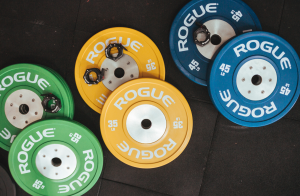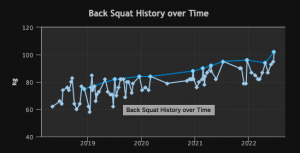What is Progressive Overload
Progressive overload is a training principle where the demands on the body are gradually increased through your training routine. This increased demand provides the stimulus needed for your body to become stronger, fitter and adapt over time.
Progressive overload, usually associated with strength training and the musculoskeletal system, can also be applied to other types of exercise like running or endurance sports affecting the cardiorespiratory system.
It can be summarised simply as “doing more over time.”
Progressive Overload for Strength Training
Although a simple concept, progressive overload provides the foundations for any successful strength training routine. To get bigger and stronger, your musculoskeletal system must continually work harder than it is accustomed to. The demands placed on your muscles must be increased over time to provide the stimulus needed to make them grow or become stronger.
Conversely, a decrease in the demands on the musculoskeletal system will cause your muscles to atrophy, losing size and strength. Skeletal muscle is highly metabolically active tissue. If the body doesn’t require the muscle to perform its daily tasks it will reduce the amount it has to keep energy reserves for other bodily functions.
How Does Progressive Overload Benefit Training?
The human body, particularly the musculoskeletal system, is highly adaptable. If you always complete the same workouts or use the same weights every time you train, your body will adapt and your gains will plateau. While it might seem like a good thing to easily lift weights that were once challenging, it will no longer provide the required stimulus for the musculoskeletal system to continue making adaptations.
Progressive overload will help you avoid training plateaus by continually stressing and challenging your muscles, providing the stimulus by which they break down, rebuild, and get stronger.
Examples of Progressive Overload Training
The different methods of incorporating progressive overload into your training fall into four categories.
- Increased load
- Increased Volume
- Increased Intensity
- Increased frequency
Let’s take a further look at these categories
Increased Load
The most obvious, and often most utilised way to incorporate progressive overload into a strength training routine is to increase the load or weight. While adding weight to an exercise is often the first way people incorporate progressive overload into their training, it is important to master the exercise first, ensuring proper form before increasing the weight.
If you can comfortably squat 70kg for 10 reps, then continuing to complete your training sessions with that weight will no longer give your musculoskeletal system the stimulus needed to adapt. They can already comfortably handle that load and have no reason to get bigger or stronger. Adding some weight so that the last 2-3 repetitions of each set become challenging will further challenge the musculoskeletal system forcing it to respond to the greater challenge.
It is important to remember that when you do increase the weight, the repetitions you can complete of that exercise will likely decrease. This is ok. You will become stronger and more comfortable with the new weight and the cycle can start again.
Increased Volume
Training volume is measured by multiplying the number of sets by the number of repetitions completed in a workout. The training volume can be increased by increasing the number of sets or reps of an exercise, or multiple exercises, in any given workout.
Using the same example as above, if you can comfortably squat 70kg for 10 repetitions but increased the number of sets from 3 to 4 from one workout to the next, you increase your training volume for squats by 25%. If you increased the number of repetitions from 10 to 12, completing 3 sets of 12, you increase your training volume for squats by 20%.
Training volume can also be increased by adding further exercises into your workout routine.
Increased Frequency
Another way to work progressive overload into your routine is to increase the frequency with which you train. This can be done by increasing the number of days, increasing the total number of sessions, or increasing the number of times you train a particular body part each week.
Increased Intensity
The intensity of your workouts has the most variables and can be modified in several ways, such as:
- Reducing rest time between sets
- Doing more work in the same time
- Doing the same work in less time
- Lifting a load with a modified tempo
- Lifting a load with increased range of motion
- Utilising weightlifting techniques such as drop sets, super sets, negatives, isometric holds, pauses, and partial reps along with your normal working sets
These are all examples of increased training intensity and will affect your training in varying ways. As mentioned above, it is important to first master the exercise you are doing before increasing the intensity of that exercise.
Applying Progressive Overload to Your Training
Although you can utilise any of the above methods in your training routine, it’s best to focus on one at a time such as increasing the load. As the body adapts to the new demands you can add another method to continue that adaptation. After all, there’s only so long you can continue to add more weight to the bar.
The method of progressive overload you use will ultimately depend on the goals for your training and the type of training you do. If strength is your main focus, increasing the load may be the best option. If you are focusing on building muscular endurance, increasing repetitions of an exercise and/or decreasing rest between sets would most likely work better for you.
Proper implementation of progressive overload also requires the athlete to use a standardised technique with proper form, range of motion and execution.
Strength gains can only be adequately measured if the lifts are done the same way every time. It can be easier to lift a heavier load with a reduced range of motion or sloppy form. Just because you lifted the heavier weight does not necessarily mean you got stronger.
Using correct form should always be the number one priority, both to cement your strength gains and help prevent the occurrence of injuries from your training. Do not sacrifice form for an increase in load or volume.
Who Should use Progressive Overload Training?
Anyone who is consistently training should go through some form of progressive overload over time. It is likely you already use, or have used, some form of progressive overload in your training if you train regularly. The method and rate of progressive overload will vary based on many factors such as training age, sex, genetics, nutrition, routine, and goals.
The rate at which overload is applied will be much greater for beginners compared to advanced athletes. In the first few months of a person’s training journey, they can expect to see massive improvements in strength, coordination and range of motion. It is not uncommon to see beginners increase the weight or repetitions they can complete of a certain movement every week in those initial months. The training stimulus needs to be modified accordingly to meet these rates of change.
This does not mean that a beginner should be adding 5kg to their squat every week. Beginners may have to work on the fundamentals of the exercise to start with, focusing on increasing their range of motion or improving their position. These things can also be considered a form of progressive overload for that person as the demands on the musculoskeletal system will be greater.
Conversely, an experienced lifter will see much slower progress over time. Other variables such as exercise selection, volume, and intensity may need to be modified to see continued training adaptations.
Things to Keep in Mind
Progressive overload needs to be implemented gradually. Increasing the load, intensity or frequency of your training too quickly can be dangerous and can lead to injury.
Certain movements will also require smaller jumps in load over time. You will generally be able to add more weight more often to bigger compound movements like deadlifts, squats and presses compared to isolation movements such as curls or lateral raises.
Progressive overload and the gains you make from your training will not always occur in a linear fashion. Overall the trend line should increase, but any adaptations your body makes to your training routine will happen in waves. Below are two examples of this taken from some of our members performance history. While the trend line mostly moves in an upward trajectory, there are peaks and troughs along the way.
While continually adding 5kg to our major lifts every month would be awesome, it would also be physically impossible. Some days, weeks, or even months will feel better than others but sometimes you may feel weaker and may even go backwards from time to time.
A well thought out strength program should have regular de-load weeks programmed into it. Having periods where the load, volume, or intensity is reduced or modified can actually help improve performance, prevent injury and overtraining, and can help you continue to progress over time.
If you need help with your training and want to see how progressive overload works and its application through a regular training routine, come to train with us at CrossFit Bayswater. https://bit.ly/trialcfbw



